Wild Africa Trek – An In-Depth Review of the VIP Backstage Tour at Disney’s Animal Kingdom
Disney describes the Wild Africa Trek as “[a] privately guided VIP expedition offering close encounters with exotic African wildlife in their native habitat.” In other words, the Wild Africa Trek is a tour that builds upon the experience of Kilimanjaro Safaris by taking you to areas of the Harambe Wildlife Reserve that you may have seen on Kilimanjaro Safaris, but only from afar. This article takes an in-depth look at the Wild Africa Trek experience, details the cost associated with the tour, responds to possible FAQs from those considering the tour, and, ultimately, attempts to the answer the question: Is the Wild Africa Trek worth its cost?
Experience
Checking (and Strapping) In
Check-in for Animal Kingdom’s Wild Africa Trek takes place next to the entrance to Kilimanjaro Safaris. When you arrive, a cast member will verify your registration, inform you that there will be no restrooms available for the first two hours or so of the Trek, and subtly suggest that you take advantage of the the restrooms available around the corner before suiting up.
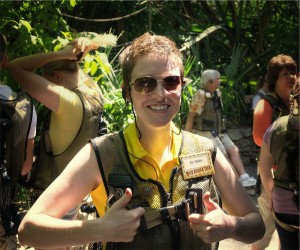
Once through the initial check-in, you’ll get a locker to store everything you cannot securely attach to your vest and/or harness. The “attached to the vest” restriction can be confusing with respect to cameras, but – according to the cast members with whom we talked – a camera strap that hangs around your neck will suffice. During this phase, cast members will also provide croakies for your glasses or sunglasses, a nametag, and a keepsake water bottle that clips to your vest.
After your belongings are secured in the locker, a cast member will fit you with a vest and harness. The harness fits snugly, through and around your legs. For this reason, and also probably because the trek includes walking across exposed bridges, Disney recommends that women do not wear skirts or dresses for the Wild Africa Trek. Based on her experience with the harness straps, my wife would also recommend that women do not wear very short shorts.
Once you are all strapped into your harness, you are weighed to verify compliance with the 300 lb weight limit (those of you who are scale-shy shouldn’t worry; there are no giant flashing numbers), provided a radio earpiece to hear the guides, and encouraged to take advantage of the available sunscreen and bug spray.
Starting the Tour
The first part of the tour involves walking through what our charming guides referred to as “some of the most dangerous animals in the wild:” homo sapiens. Basically, you walk from the Wild Africa Trek check-in location to the entrance of Pangani Forest Exploration Trail. On the Pangani Trail, you follow the same path as any guest, including winding through the aviary and quickly walking past the naked mole rats. Even with the additional and humorous insights provided by the Wild Africa Trek guides, this part of the tour might leave you wondering when the real tour is going to start. Thankfully, near the end of Pangani Trail, the fun really begins.
Over the River and Through the Woods
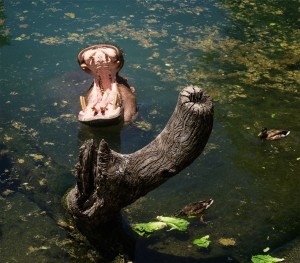
Toward the end of the Pangani Trail, your guides lead you up into the woods. This is where the real Wild Africa Trek experience begins. After a brief trail walk, you arrive at an overlook that extends out above the hippopotamus pool. Your guide will clip you (via your harness) to a support railing that allows you to move up to the edge of the overlook without fear of falling into the hippos’ gaping maws. The primary guides provide some hippo insight, but the group is also joined by a “hippo expert”, who provides you with information about feeding habits and the hippos’ relationships with one another, and, most importantly, brings large quantities of lettuce to coax the hippos closer to the overlook.
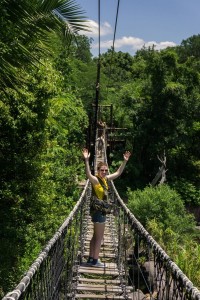
Next comes the rope bridge across the crocodiles. Those who have experienced Kilimanjaro Safaris have driven under this bridge (really two bridges connected by a platform tower) and may have noticed cast members or Wild Africa Trek groups traversing it. The rope bridge is not particularly difficult to navigate, though it was a little more wobbly than I had expected and I appreciated the fact that I was clipped into a safety line. Every member of the group will go across the bridge individually, and you are free to stop along the way to take pictures (assuming you have the courage to let go of the railings).
Since the bridge takes you literally over the crocodiles (don’t fall!), it shouldn’t be much surprise that the next stop is to view the crocodiles a little more closely. Just as with the hippopotamus overlook, you are attached to a safety rail so that you can inch up to the edge, and you are joined by a crocodile expert with interesting tidbits of information. Now is a great time for pictures: apparently natural models, crocodiles will hold a given pose (such as showing off their jaws) for quite some time.
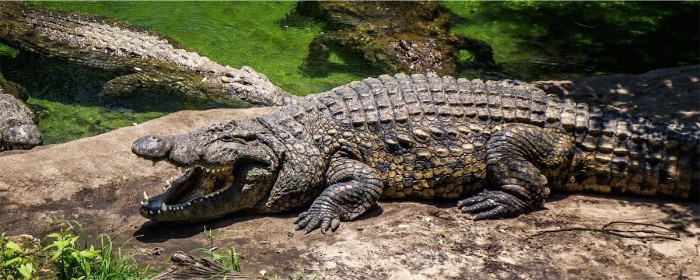
Riding (and Stopping) in the Savannah
After you wave goodbye to the crocodiles, you’ll also say goodbye for to your vest, harness, and earpiece, and hello to back of a safari truck. The Wild Africa Trek vehicles are different from those on Kilimanjaro Safaris. Your vehicle for the Trek features benches along the outer edge of the bed of the truck, with a wide open area in the middle. This allows for everyone to face one another, and the guides, while riding through the Harambe Wildlife Reserve, and, more importantly, provides a nice empty space for everyone to stand when the truck stops. Yes, unlike Simba–1 on Kilimanjaro Safaris, this truck will stop, and your guides allow you to stand to get a better view of the animals on the reserve. If you are a photographer, this fact alone might make the Wild Africa Trek worth its price.
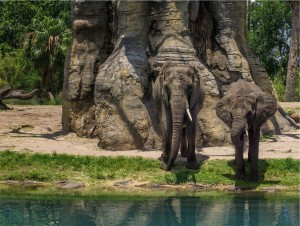
Other than the truck’s configuration and the opportunity to stop for several minutes at various places along the tour, what you see during the ride through the Harambe Wildlife Preserve is nearly identical to what you would experience on Kilimanjaro Safaris. This includes views of the springboks, giraffes, elephants, and other savannah animals. However, since you have so much more time, you hear much more information. Our guides were very knowledgeable and the other guests had great questions. For example, we learned that one of the giraffes was pregnant, and it appears that Disney’s Animal Kingdom (or Animal Kingdom Lodge) will have another baby giraffe sometime in 2015.
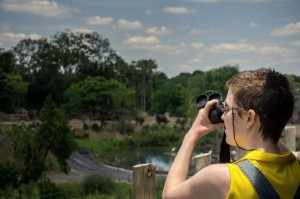
When you are about two thirds of the way through the traditional Kilimanjaro Safaris trail, near the flamingo pool, the Wild Africa Trek again diverges from the standard experience. It is at this point that you stop at a boma for a meal and more animal-viewing. Note that boma simply means an area for outdoor meals and parties, and you are not going all the way to Boma, the restaurant at Animal Kingdom Lodge. The boma on the Wild Africa Trek is a large, beautiful observation deck with views of substantial sections of the Harambe Wildlife Reserve. The front of the observation deck, where there are tables and chairs, has fantastic views of the elephants, the flamingo pond, and the grasslands populated with many other animals; the rear of the observation deck provides a (binocular-assisted) view of the rock formation that the lions call home.
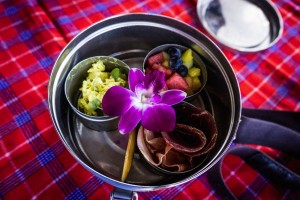
The meal provided at the boma is specially prepared by the kitchen at Tusker House and differs depending on the time of day (i.e. breakfast for morning tours, lunch for afternoon tours.) For example, a breakfast meal includes brie, various fruits, and yogurt with granola, while lunch features items such as smoked meats, salmon roulade, and shrimp. If any of that sounded appetizing to you, then you are in for a treat on the Trek. The food is excellent, and, as our guides pointed out, the boma on the Wild Africa Trek is the only place at Walt Disney World to get these items. With classic Disney Magic touch, even the flower accompanying the meal is edible and tasty.
Finishing out the Tour
After relaxing at the boma, and taking in the views from both sides of the observation deck, it is time to pile back into the safari truck to finish the tour. As before, the truck travels a route similar to that of the Kilimanjaro Safaris ride vehicles, but it has the benefit of stopping and allowing you to stand and take pictures of the animals along the way.
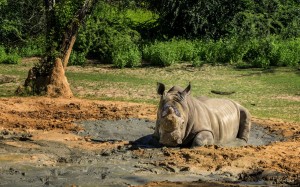
The tour ends at the same place that Kilamonjaro Safaris concludes. At this time, the tour group and guides all must walk back to the lockers, where personal belongings were stored approximately three hours prior, and say your tearful goodbyes.
Cost
During most of the year, the Wild Africa Trek costs $201.29 per person. During peak times, however, the price tag jumps to $265.00. Peak times include: the weeks of Christmas, New Year’s Eve, Easter, and a period Disney defines as “spring break” (which changes from year to year and has not yet been set for 2015.) You must pay for your tour, in full, at the time of booking, and if you have to cancel, you must do so more than two days in advance if you wish to receive a refund. The tour takes place rain or shine, so it would be a good idea to pay attention to the weather forecast if the thought of experiencing the Wild Africa Trek in the rain does not appeal to you.
Through October 25 of this year (2014), Disney is offering a $50 discount, per person, on “afternoon” tours (i.e. tours that start at 11:30 AM or later.) At nearly 25% of the cost of the tour, this is a fairly substantial discount. Of course, if you are traveling in July or August, saving $50 per person might not be enough to make a three hour tour in the Florida heat (or afternoon thunderstorms) enjoyable.
At the time of publication, the cast members I spoke with informed me there is no current Annual Pass discount available for the Wild Africa Trek. When I booked my tour earlier this year, however, I received a discount of $50 per person that the cast member handling the booking attributed to my status as an Annual Passholder. Consequently, I encourage Annual Passholders to ask for any potential discounts when booking their tours.
Questions
How do I book a reservation for the Animal Kingdom’s Wild Africa Trek?
Reservations for the Wild Africa Trek made by calling (407) WDW-TOUR (i.e. (407) 939–8687.)
What should I wear on the Wild Africa Trek?
Sunscreen, bug spray, comfortable walking shoes (but they don’t have to be made for hiking – I did just fine in sneakers and my wife wore Converse), and breathable materials in temperature appropriate styles.
What should I not wear on the Wild Africa Trek?
Flip flops (or other shoes that could easily slide off), dresses, skirts, or any clothing that would be uncomfortable when you are in the vest and harness. Take a look at the harnesses used in mountain climbing and ropes courses to see where the straps of the harness hit the body, and do what you can to avoid chafing.
What are the physical demands associated with the Wild Africa Trek?
- THE WALK: The total walking on the tour probably clocks in just under 2 miles (through the prohibition against non-vest-attached cellphones meant I didn’t get a precise calculation.) I would suggest taking a couple trips around Epcot’s World Showcase to gauge how comfortable you feel walking that distance over 90 minutes or so.
- THE BRIDGE: As I noted above, the rope bridge is a little more wobbly than I anticipated it would be. Additionally, some boards are “missing” from the bridge which means that you have to step over sizable gaps (though I didn’t have a measuring tape with me, I would guess the largest gap was around 16–18 inches, and there is a safety net under the entire bridge which is visible through the gaps). Despite the wobbliness and the gaps, my wife Elyssa, who is not particularly fond of heights, and the rest of the our group had no real issues traversing the bridge. Ultimately, it comes down to your particular sense of balance and your comfort with being approximately two stories off the ground.
- THE BATHROOMS: There are no restroom facilities for the first two hours or so of the tour. A cast member will most likely remind you of that fact before you are strapped in the harness, but it is probably a good idea to hit up the restrooms in Harambe Village before you check-in. There is a bathroom once you get to the boma about two thirds of the way through the Trek.
Should I bring my camera (smartphone or stand alone?)
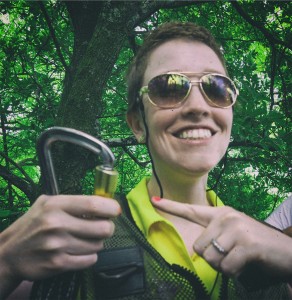
This depends on how much of the experience you want to capture. The guides will take pictures of the group and the animals frequently throughout the Trek, and I felt our particular guides did a good job of getting shots of each individual party within the overall group. After the tour, you receive access to a website that allows you to download the guides’ photos and a “greatest hits” set of photos from other tours. I probably would have been content had the guide photos been all I received.
I was happy, however, that I brought my own camera. It allowed me to take more candid shots of my wife enjoying the experience than the guides did. As noted earlier in the post, you do have to either attach your camera to your vest or hang it around your neck to be allowed to bring it. Though smartphone photographs would probably be sufficient to get the extra documentation you may want from your Wild Africa Trek experience, the requirement of attaching your phone to your vest might make it easier to go with a compact camera. I found it much easier to find a suitable camera strap for my camera than to find an iPhone case/strap that would keep my phone connected to my vest while I took pictures.
Does the Wild Africa Trek photo download include other Disney Photopass photos from the rest of my vacation?
No. In fact, you go to a special website – which appears to be separate from the Disney Photopass site – to download your images.
Is it Worth it?
The Wild Africa Trek is fantastic. Both my wife and I enjoyed it thoroughly, and, but for the cost associated with the Trek, would love to take the tour each and every time we go to Walt Disney World. Of course, in reality, the more than $200 per person price tag must be factored into the decision. Thankfully, Disney packs a lot into the Trek to justify the $200 cost, including: access to areas of Disney’s Animal Kingdom not available to regular guests, up-close encounters with animals not available through any other Disney attractions, a meal available only on the tour, full photographic documentation of the experience, and, of course, your awesome water bottle.
If you have never experienced the Wild Africa Trek, have at least a passing interest in animals, and think you might enjoy the experience described above, then the answer is simple: Yes. Go on the tour. If, however, you still have questions about whether you would enjoy three hours walking and driving mostly in the Florida sun, then you might have to think a little harder about whether this experience is right for you. The goal of this post is to provide enough detail for you to make a well-informed decision.
When my wife and I look back on our last few trips to Walt Disney World, it is the Wild Africa Trek that we list as our “Number One Highlight.” For us, the Wild Africa Trek was definitely worth its price tag.
After reading about the Wild Africa Trek, are you interested in going on the tour? What other Disney VIP tours have you been on? Let us know what you think in the comments.
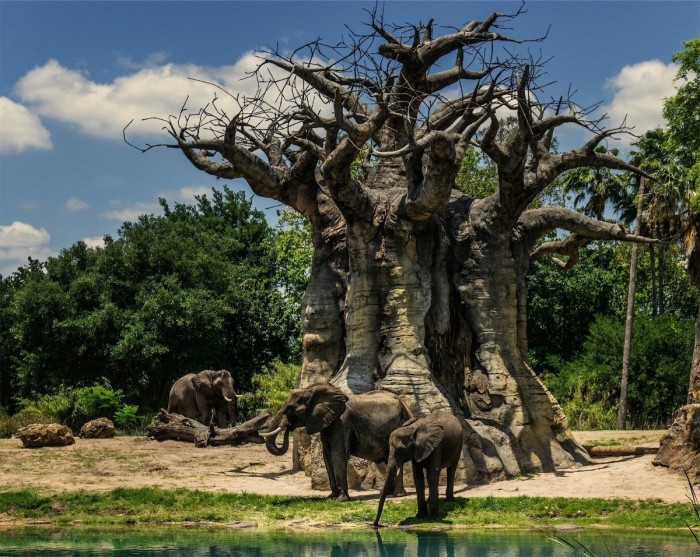





what is the age requirement?
8 years and at least 48 inches (122 cm) tall.
See https://disneyworld.disney.go.com/events-tours/animal-kingdom/wild-africa-trek/
Thank you, after visiting the link you posted, I measured my 8 year old and found out that she is exactly 48 inches….. and we will be doing this on our next visit!!!
I am interested in knowing is an AM or PM tour better due to animal activity, etc. Heat doesn’t bother us.
Good question, and even better timing. Today, Disney published findings from a study it performed on animal activity at Disney’s Animal Kingdom. The result? Time of day does not significantly change the probability of spotting animals. (You can read more details here: http://disneyparks.disney.go.com/blog/2014/07/wildlife-wednesday-myth-busters-whens-the-best-time-to-see-your-favorite-animals-at-disneys-animal-kingdom/)
So, if you believe Disney’s study, an AM or PM tour should not result in different levels of animal activity. One alternative factor you may wish to consider: Would you rather eat the brie, various fruits, and yogurt with granola they serve at breakfast, or the smoked meats, salmon roulade, and shrimp they serve at lunch?
We did an 8am tour in August 2012. Rather than “Check-in takes place next to the entrance to Kilimanjaro Safaris”, because our tour started before the park opened we had to check-in just outside the main turnstiles.
Our group was of 12 people, I assume this is the maximum. The cast members were fantastic. Disney supplied a total of 187 photos (in 2012 it was on a PhotoCD that arrived in the post a few weeks later), the vast majority were our of tour rather than being stock photos. At the boma the CMs were happy to oblige by taking numerous individual and family/group photos.
My kids still remember eating the flower during the meal! We threw the souvenir water bottles away as the screw lids kept getting cross-threaded.
We didn’t do the normal Kilimanjaro Safaris ride, there seemed little point when the tour offered so much more. It was definitely worth the money.
Adding this to my Disney Bucket List immediately! Looks like a must-do, especially for been-there, done-that types like our family. Thanks for all the information and photos!
I booked this tour a few days ago for my husband and myself in September, and with the discount it was just under $300 for the two of us including tax. We’ve been going to WDW every year for several years and this is our first tour, and I’m very excited. One question – is the meal a full meal or more like a snack? We’re doing the 1:30 tour and have dinner reservations at 7:30. I’m just wondering if we’ll be too full to enjoy dinner.
I would classify it as a “light lunch.” If you need more details than what I put in the review, Disney’s official explanation of the meal (available here: http://disneyparks.disney.go.com/blog/2011/02/wild-africa-trek-you-cant-feed-the-animals-but-you-get-to-eat/ ) has another picture of what you will be served.
If I was taking the 1:30 PM tour, I would eat something light for lunch around 12:00-12:30 PM before going on the tour, and have the meal on the tour around 3:15-3:30 PM, and then I would be ready for dinner at 7:30 PM. If I was really concerned about maximizing my value when it comes to dinning options, I might not schedule a buffet or similar “all you care to enjoy” meal for that 7:30 PM reservation.
Again, that is based on my eating habits, but hopefully it gives you a little more insight. Please let me know if you have any other questions.
Thank you for your more than through review. I think I am putting this on my list for October.
My family of 4 and another family of 4 are doing this together this August. This will be our 4th trip to the World but our first Wild Africa Trek. I am looking forward to this tour the most out of our entire trip. We got the $50 per person discount and are taking the 11:45 tour. For all 8 of us that’s a $400 savings – so we’ll tough it out in the Florida heat. Can’t wait!
My wife and I did this tour in 2011, and it was great. (To be fair, we’re the kind of people who will stand in line and ride Kilimanjaro Safaris 2 or 3 times in one trip.) It’s definitely not for Disney-on-a-budget, but if you can afford it, it’s not going to let you down.
As for the weight limit, I think it used to be 250, and when I did it I was probably about 230, but they never brought out the scale to check. I’d imagine that 300 is closer to the actual safety rating of the equipment, which is why they need to break out the scale now.
This is on my Disney bucket list. Thanks for the great article. I think when the trek first started, the weight limit was lower, I remember thinking that I wouldn’t qualify. (I’ve lost weight, so it is not any issue any way now for me.) If I ever do a solo trip to WDW, this will be my big slurge.
My wife and I have looked very carefully at this adventure and are scheduled to take the Trek on Sep 5 in the morning. We too believe this will be the highlight of our next visit. I was a bit disappointed in the reservation process. You call and give your credit card info (charging the full amount) and all you get in return is a number. No email no hard copy. We were told to ask at check in about our DVC or Disney Visa card discount. There was no discount available at the time of reservation. Then the reservation does not link to My Disney Experience. You can only make a note. Something for the Mouse to work on! Really looking forward to the experience though!
My 11-year-old daughter (who loves animals) & I did the Trek in Oct 2013. I agree that it was totally worth the cost! It was a wonderful experience that tops anything else we’ve done at Disney. Although we were both nervous about the bridges, being harnessed made it a very safe-feeling experience & ended up being one of the highlights of the experience (I will warm that short-legged people will have to stretch to make a couple of the gaps based on my 5-foot-tall daughter’s experience, but she says that was part of the fun). Being able to stop during the drive portion of the safari was great as well—but do be alert & listen to the guides as you may need to suddenly sit back down to move along quickly should the animals take an extra interest in you (they are wild animals!)—we had an up-close encounter with the rhinos when they decided to come check us out! The trek was definitely worth every penny & we would love to be able to do it again.